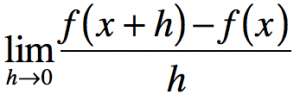Today we continued examining the connections between the graph of a function and the graph of its derivative. We noticed that when the tangent is at the top of a hill or the bottom of a valley, the tangent line is horizontal….or has a zero slope. We also noticed that when the original curve has tangents with negative slopes, the slope function occurs below the x-axis. Further, when the tangents have positive slopes, the slope function is graphed above the x-axis.
We discussed how every curve can be created by a small arc. We can then rotate duplicates of this arc and create almost every curve. We briefly discussed how the curve increases and decreases as we move from left to write. We identified pieces which can be described as….
- positive, increasing slopes
- positive, decreasing slopes
- negative, increasing slopes
- negative, decreasing slopes
You might check out the following applet derivative puzzles to practice identifying the graphs of derivatives without knowing the equation of the original function.

